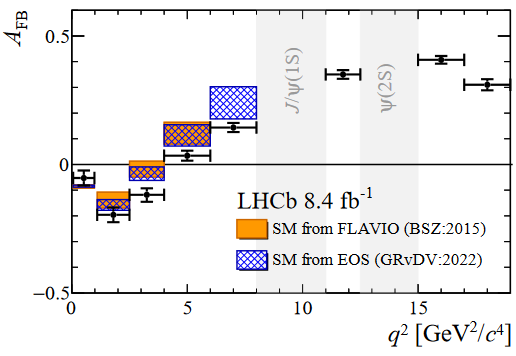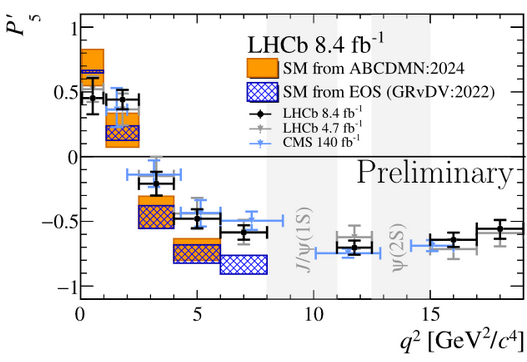Last week at the LHCC open session and this week at a CERN seminar, the LHCb collaboration presented the legacy results from Run-1 and Run-2 data of the angular distributions of B0→K*μ+μ– decays.
The analysis of B0→K*μ+μ– decays presents a promising method for exploring the potential effects of undiscovered particles (see the CERN Courier article for an introduction). At the quark level, this decay involves the transition from a b-quark to an s-quark, along with the production of a muon pair (μ+μ–). These transitions are sensitive to virtual contributions from new particles, which could have masses that are inaccessible to direct searches at the LHC. By comparing precise measurements of the decay’s properties with Standard Model (SM) predictions, possible indications of new fundamental particles or interactions can be revealed.
The best sensitivity to new particles comes from the study of the angular distribution of the decay products, in this case, the kaon and the pion from the K* decay, and the muon pairs. Physicists from the LHCb experiment have studied different angular observables as functions of the invariant mass squared, q2, of the muon pair. They analysed a set of optimised observables that have reduced theoretical uncertainties that arise due to the hadronic physics involved in turning a B meson into a K* meson (so-called form factors). These observables are therefore ideal to search for new particles contributing to the amplitude of the decay. It is one of these observables, “P5‘“, that showed a local deviation with respect to the SM predictions at a level of 3.7 standard deviations (σ) in one q2 bin in the 2011 1fb-1 data sample, as presented at the 2013 EPSHEP conference in Stockholm. Subsequent LHCb analyses with larger data samples [1] and [2] confirmed the tension with the SM prediction. In particular, when performing a global fit to all measured observables of the decay, the analysis in [2] reported a 3.3 σ deviation from the SM.
This latest measurement represents the most sophisticated analysis of the B0→K*μ+μ– decay properties to date, and uses 8.4 fb−1 of proton-proton collisions collected by the LHCb experiment in the years 2011, 2012 and 2016–2018. A global fit to the measured observables gives a tension with SM predictions of 4σ and is consistent with tensions seen in similar decays.

The images above show the distributions of the P5’ observable, as well as the forward-backward asymmetry, AFB. The q2 regions affected by the presence of the J/ψ and ψ(2S) charmonium resonances are not included in the analysis. The new results obtained with 8.4 fb-1 of integrated luminosity are compared also with previous LHCb and CMS results. The new results are in good agreement with the previous measurements by LHCb, which they supersede, and also with a recent CMS measurement. The new measurements continue to exhibit the pattern of tensions with the Standard Model predictions that have been seen in previous analyses.
Further information can be found in the presentations given at the LHCC open session and the CERN seminar. All results will be published in due course. See also a CERN home web page version of this news and an animation showing a proton-proton collision inside the LHCb detector followed by a B0 meson decaying into a K* and a pair of muons.

